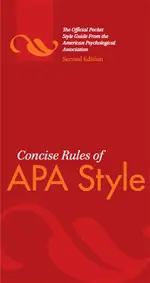

Concise Rules of APA Style (Concise Rules of the American Psychological Association (APA) Style) Spiral-bound –
Pages
284
Publisher
American Psychological Association
Published
7/30/2009
ISBN-13
9781433805608
The Concise Rules of APA Style, Sixth Edition offers essential writing and formatting standards for students, teachers, researchers, and clinicians in the social and behavioral sciences. This easy-to-use pocket guide, compiled from the sixth edition of the Publication Manual of the American Psychological Association, provides complete guidance on the rules of style that are critical for clear communication.
Readers will learn how to avoid the grammatical errors most commonly reported by journal editors; how to choose the appropriate format for statistics, figures, and tables; how to credit sources and avoid charges of plagiarism; and how to construct a reference list through a wide variety of examples and sources.
In addition to guidance on grammar points that have challenged writers in the social sciences, the Concise Rules provides suggestions for reducing bias in language; reviews the mechanics of style for punctuation, spelling, capitalization, abbreviation, italicization, headings, and quotations; examines the preferred use of numbers as well as standards for metrication and statistics; provides guidance on the construction and formatting of tables, figures, and appendixes; and offers clear examples and models for citing sources and constructing error-free reference lists.
Available in a light-weight, spiral-bound format, the Concise Rules will travel easily from home to school to office. It will be an invaluable reference tool for all social science scholars who are serious about communicating clearly and effectively.
Key to this edition is an updated and expanded APA Style website, with many additional resources to help readers learn APA style, including free tutorials, on-line courses, frequently asked questions, sample papers, and the APA Style blog.
The sixth edition of Concise Rules has been revised and updated to include
New and experienced readers alike will find the sixth edition a complete resource for writing with clarity and precision.
How does the Concise Rules differ from the Publication Manual of the American Psychological Association?
The Publication Manual remains the best source for broad background information about scientific publishing. In addition to writing style rules, it provides detailed guidance on publication ethics, journal article reporting standards, and the process of journal publication.
The Concise Rules, by comparison, targets only those rules writers need for choosing the best words and format for their articles. It offers a comprehensive list of essential writing standards in a convenient, easily retrievable format.
Whilst not strictly 'theological', numbers of academic institutions are mandating this style for papers!
Readers will learn how to avoid the grammatical errors most commonly reported by journal editors; how to choose the appropriate format for statistics, figures, and tables; how to credit sources and avoid charges of plagiarism; and how to construct a reference list through a wide variety of examples and sources.
In addition to guidance on grammar points that have challenged writers in the social sciences, the Concise Rules provides suggestions for reducing bias in language; reviews the mechanics of style for punctuation, spelling, capitalization, abbreviation, italicization, headings, and quotations; examines the preferred use of numbers as well as standards for metrication and statistics; provides guidance on the construction and formatting of tables, figures, and appendixes; and offers clear examples and models for citing sources and constructing error-free reference lists.
Available in a light-weight, spiral-bound format, the Concise Rules will travel easily from home to school to office. It will be an invaluable reference tool for all social science scholars who are serious about communicating clearly and effectively.
Key to this edition is an updated and expanded APA Style website, with many additional resources to help readers learn APA style, including free tutorials, on-line courses, frequently asked questions, sample papers, and the APA Style blog.
The sixth edition of Concise Rules has been revised and updated to include
- simplified APA heading style to make it more conducive to electronic publication;
- updated guidelines for reducing bias in language to reflect current practices and preferences, including a new section on presenting historical language that is inappropriate by present standards;
- new guidelines for reporting inferential statistics and a significantly revised table of statistical abbreviations;
- a new discussion on the use of online supplemental materials, including lengthy data sets and other media, to enrich the published article;
- significantly expanded content on the electronic presentation of data to help readers understand the purpose of each kind of display and choose the best match for communicating the results of the investigation, with new examples for a variety of data displays, including electrophysiological and biological data;
- an expanded discussion of electronic sources, emphasizing the role of the digital object identifier (DOI) as a reliable way to locate information; and
- a wealth of new reference examples, with a focus on new electronic formats.
New and experienced readers alike will find the sixth edition a complete resource for writing with clarity and precision.
How does the Concise Rules differ from the Publication Manual of the American Psychological Association?
The Publication Manual remains the best source for broad background information about scientific publishing. In addition to writing style rules, it provides detailed guidance on publication ethics, journal article reporting standards, and the process of journal publication.
The Concise Rules, by comparison, targets only those rules writers need for choosing the best words and format for their articles. It offers a comprehensive list of essential writing standards in a convenient, easily retrievable format.
Whilst not strictly 'theological', numbers of academic institutions are mandating this style for papers!